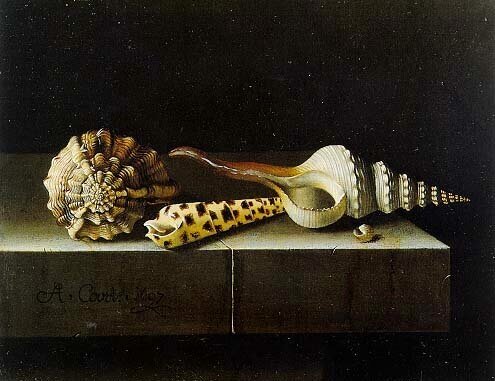If You Think You Are Out of Sync..
you might examine the life and work of Dutch painter, Adriaen Coorte, who painted in the city of Middelburg in the later 17th Century. He wasn’t known to his contemporaries and his work was miles different from the elaborate still lifes of his Golden Age peers. Imagine trying to make a living as an artist in the wake of masters like Rembrandt and Frans Hals, while Johannes Vermeer was painting The Milkmaid and The Girl with the Pearl Earring next door in Delft?
Very little is known about Adriaen’s life and he lived and died in his hometown, making small and unpretentious still lifes in a style more typical of the first half of the century. His work most often depicts a single, brilliantly lit object against a dark background. Coorte developed his subjects in detail and was able to make elegant use of light in his compositions. Many of Coorte's still lifes are painted on paper pasted onto panel, a rather unusual method in the seventeenth century. All follow the same compositional formula, namely very small quantities of fruits, vegetables, or shells, sometimes even a single fruit or vegetable, placed on the edge of a stone slab, illuminated from above, with a dark background. A few rare butterflies break up this dark area, adding a splash of color.
What is extraordinary about all this is how counter-cultural it was. Dutch still life at that point in the 17th Century was an extravagant response to the wealth reaped from overseas trading and still life paintings evolved into magical cornucopias featuring hundreds of expensive, exotic objects. Writer Julia Fiore called the embarrassment of riches in these paintings “commodity fetishism”. In that light, Coorte’s compositions are breathtakingly out of fashion.
In or out of style, I discovered him when I visited the Rijksmuseum in Amsterdam. After the glories of Rembrandt and Vermeer I was stopped in my steps in a little side gallery, to study in fascination small works of glowing austerity and beauty. A bunch of asparagus. Three peaches on a plinth. Who was this painter who had such an exquisite sense of reserve? I took picture after picture on my phone and have since studied and copied some of his work in the effort to understand it’s magic.
Adriaen Coorte’s legacy has a happy ending in that art historian Laurens J Bols discovered his work in the 1950’s and built a 20th Century legacy for this 17th Century artist. In December 2014, one of his most beautiful works, Three Peaches on a Stone Ledge with a Red Admiral Butterfly sold for more than $3.5 million. Adriaen obviously didn’t live to see his celebrity, but I think it’s a meaningful lesson for the rest of us. You never know the ripples you will start in the pond when you first throw that rock. And in being true to ourselves, despite the current of our times, we never know the influence we will have on the future. If your creative urges, or anything else about the way you see the world, seem out of place, please take heart. We never really know the end of the story. So just do it.





